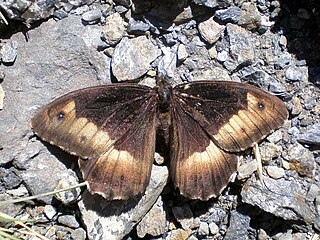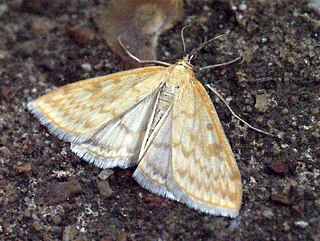
Catocala coniuncta is a circum-Mediterranean species of moth whose range extends across southern Europe, North Africa and extending to the Middle East. Its species name has for a long time been misspelled "conjuncta"; this was only corrected in 2010.

Hipparchia fagi, the woodland grayling, is a butterfly of the family Nymphalidae.

Sitochroa verticalis, common name lesser pearl, is a species of moth of the family Crambidae.

Etiella behrii is a species of moth of the family Pyralidae, occurring sporadically but when present considered a serious pest of agricultural crops throughout parts of Australia.

Muschampia floccifera, the tufted skipper or tufted marbled skipper, is a butterfly of the family Hesperiidae.

Pammene aurana is a moth of the family Tortricidae.

Clepsis consimilana, the privet tortrix, is a moth of the family Tortricidae.

Ectoedemia turbidella is a moth of the family Nepticulidae and is found in most of Europe. The larva mine the leaves of poplar trees and was first described by the German entomologist Philipp Christoph Zeller in 1848.

Batrachedra arenosella, the armoured scale eating caterpillar or the coconut moth, is a species of moth of the family Batrachedridae. It was first described by Francis Walker using specimens collected in Auckland, New Zealand. It has been hypothesised that the New Zealand moth may contain two distinct species. As well as the moth species in New Zealand, this name has been applied, perhaps incorrectly, to moths found in India, Indonesia, the Malay Peninsula, and Réunion, as well as in Australia, from the Northern Territory and northern Queensland to New South Wales and South Australia.

Coleophora deviella is a moth of the family Coleophoridae. It is found from Denmark to Spain, Sardinia, Sicily and Greece and from Great Britain to southern Russia. It occurs in desert-steppe and desert biotopes.

Coleophora therinella is a moth of the family Coleophoridae found in Asia and Europe.

Pancalia leuwenhoekella is a moth in the family Cosmopterigidae.

Agonopterix conterminella is a moth of the family Depressariidae which is found in Asia, Europe and North America. It was described by Philipp Christoph Zeller in 1839 from a specimen found in Augsburg, Germany. The larvae feed on the terminal shoots of willows.

Bucculatrix ulmella is a moth of the family Bucculatricidae. It is found in most of Europe, except the Iberian Peninsula, Slovenia and Bulgaria. It was first described in 1848 by Philipp Christoph Zeller.

Doloessa viridis is a species of snout moth in the genus Doloessa. It was described by Philipp Christoph Zeller in 1848 and is known from Indonesia, Malaysia, Sri Lanka, China, Australia (Queensland), Taiwan, the Philippines and the Solomons.

Euzophera cinerosella is a species of snout moth in the genus Euzophera. It was described by Zeller in 1839. It is found in most of Europe, Turkey, Russia and China.

Eudonia sudetica is a species of moth in the family Crambidae described by Philipp Christoph Zeller in 1839.

Phaulernis fulviguttella, the yellow-spotted lance-wing, is a moth of the family Epermeniidae found in the Palearctic including Europe.
Caryocolum tischeriella(Zeller, 1839) is a moth of the family Gelechiidae. It is found in Portugal, Spain, France, Germany, Austria, Switzerland, Italy, the Czech Republic, Slovakia, Slovenia, Croatia, former Yugoslavia, Romania, Bulgaria, North Macedonia, Greece, Norway, Finland, the Baltic region and Russia, as well as on Crete and Sicily. Outside of Europe, it is found in southern Siberia, Central Asia and North Africa.

Helastia siris is a moth of the family Geometridae. This species is endemic to New Zealand. It is classified as "At Risk, Relict'" by the Department of Conservation.



















